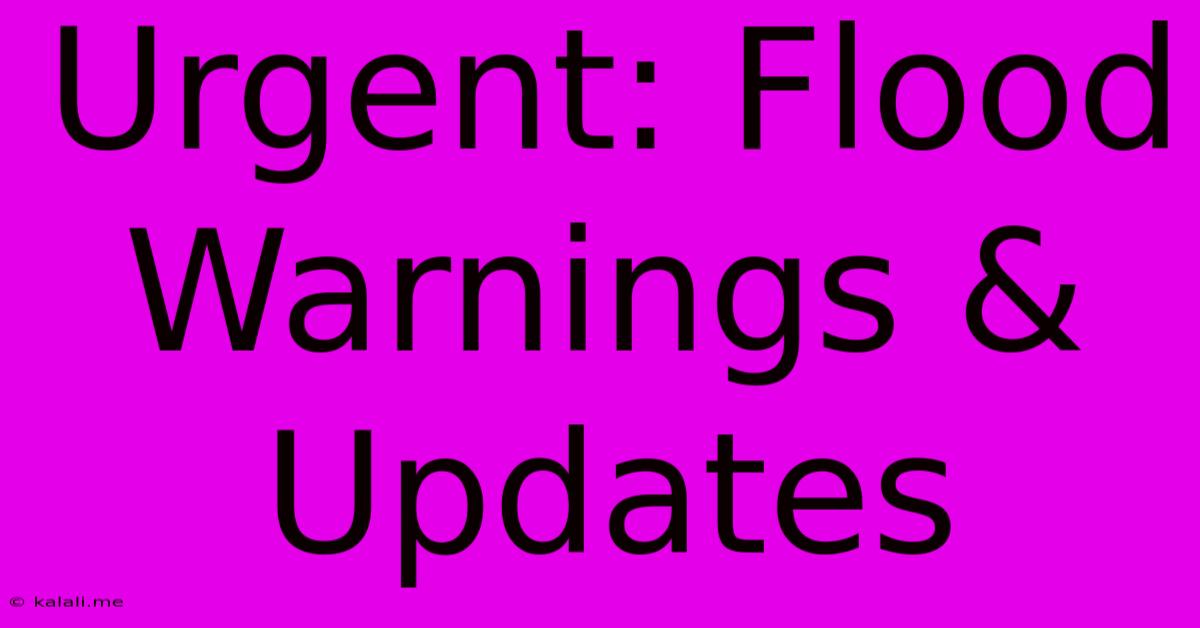Urgent: Flood Warnings & Updates
Kalali
Jan 12, 2025 · 4 min read

Table of Contents
Urgent: Flood Warnings & Updates – Staying Safe During Severe Weather
Flooding is a devastating natural disaster that can strike with little warning, causing widespread damage to property, infrastructure, and tragically, loss of life. Staying informed and prepared is crucial to minimizing risk and ensuring your safety during flood warnings and updates. This comprehensive guide provides essential information on understanding flood alerts, taking proactive measures to protect yourself and your loved ones, and knowing what to do during and after a flood.
Understanding Flood Warnings and Alerts
Flood warnings and alerts are issued by meteorological agencies and emergency services to inform the public about the potential or imminent threat of flooding. Different levels of alerts exist, each signifying a different level of risk:
1. Flood Watch: This is a preliminary warning indicating that conditions are favorable for flooding. Heavy rainfall, snowmelt, or dam failures are possible factors. Stay informed and monitor the situation closely. This is the time to prepare your home and family.
2. Flood Advisory: This indicates that flooding is occurring or is imminent. While not as severe as a warning, it still demands attention. Take necessary precautions and be prepared to act.
3. Flood Warning: This is a serious alert indicating that flooding is occurring or is expected to occur imminently. Immediate action is required to protect life and property. Evacuation may be necessary.
4. Flash Flood Warning: This is the most serious alert, signifying a sudden and rapid flood. Immediate action is critical; there is little time to react. Seek higher ground immediately.
Identifying Reliable Information Sources
During a flood emergency, it's crucial to rely on credible information sources to avoid misinformation and panic. Check your local news channels, weather websites, and official government emergency websites for the most up-to-date flood warnings and updates. Avoid spreading unverified information on social media.
Reliable sources include:
- National Weather Service (NWS): The NWS provides detailed weather forecasts and flood warnings.
- Local Emergency Management Agencies: Your local emergency management agency will issue specific alerts and instructions for your area.
- National Oceanic and Atmospheric Administration (NOAA): NOAA provides comprehensive weather information and resources.
Pre-Flood Preparations: Protecting Yourself and Your Property
Proactive preparation is key to minimizing the impact of a flood. The steps you take before a flood hits can significantly reduce the damage and improve your safety.
Creating a Family Emergency Plan
Developing a comprehensive family emergency plan is paramount. This should include:
- Designated meeting points: Establish several meeting points in case family members are separated.
- Emergency contact information: Ensure everyone has access to emergency contact numbers.
- Evacuation routes: Plan and practice evacuation routes from your home and workplace.
- Emergency supplies: Assemble an emergency kit containing essential supplies like water, non-perishable food, first-aid kit, medications, flashlights, and a portable radio.
- Pet preparedness: Develop a plan for your pets, including identification tags, carriers, and emergency supplies.
Protecting Your Property
Taking steps to protect your property can significantly reduce flood damage. These steps include:
- Elevating valuables: Move valuable items and furniture to higher levels in your home.
- Securing outdoor items: Bring in outdoor furniture, grills, and other items that could be swept away by floodwaters.
- Cleaning gutters and drains: Ensure that gutters and drains are clear to prevent water from accumulating around your home.
- Installing flood barriers: Consider installing flood barriers or sandbags around your home if you live in a high-risk area.
- Unplugging electrical appliances: Disconnect electrical appliances and electronics to prevent electrical hazards.
During a Flood: Staying Safe
When a flood warning is issued, immediate action is necessary. Your safety is the top priority.
Evacuation Procedures
If instructed to evacuate, do so immediately. Follow official evacuation orders and routes. Don't attempt to drive through floodwaters, even if they appear shallow. Floodwaters can be deceptively strong and can quickly sweep away vehicles.
Seeking Higher Ground
If evacuation is not possible or immediate, move to higher ground within your home or seek refuge in a sturdy building. Stay away from floodwaters, as they may contain hazardous materials.
Emergency Contact
Maintain communication with family and friends through phone or text. Let them know your situation and location.
Post-Flood: Recovery and Safety
After the floodwaters recede, the recovery process begins. However, significant hazards still remain.
Assessing Damage
Carefully assess the damage to your property. Do not enter your home until authorities deem it safe. Be aware of potential structural damage, downed power lines, and hazardous materials.
Cleaning Up
Cleaning up after a flood requires caution. Wear protective gear like gloves and masks to avoid contact with contaminated water and debris. Dispose of damaged items properly. Contact your insurance company to report damages.
Reporting Damages
Report flood damage to your local authorities and insurance company. This is crucial for receiving assistance and aid during the recovery process.
Conclusion: Preparedness Saves Lives
Flooding is a serious threat, but with proper preparation and awareness, you can significantly reduce its impact. By understanding flood warnings, taking proactive steps, and following safety guidelines, you can protect yourself, your family, and your property. Remember, being prepared is the best defense against the devastating effects of a flood. Stay informed, stay safe.
Latest Posts
Latest Posts
-
Why Did The Kangaroo See A Psychiatrist
Jul 06, 2025
-
How Long Would It Take To Walk To China
Jul 06, 2025
-
Step Up To The Streets Final Dance
Jul 06, 2025
-
How Many Grams Is Half An Oz
Jul 06, 2025
-
How Much Is 10 Quarters In Dollars
Jul 06, 2025
Related Post
Thank you for visiting our website which covers about Urgent: Flood Warnings & Updates . We hope the information provided has been useful to you. Feel free to contact us if you have any questions or need further assistance. See you next time and don't miss to bookmark.